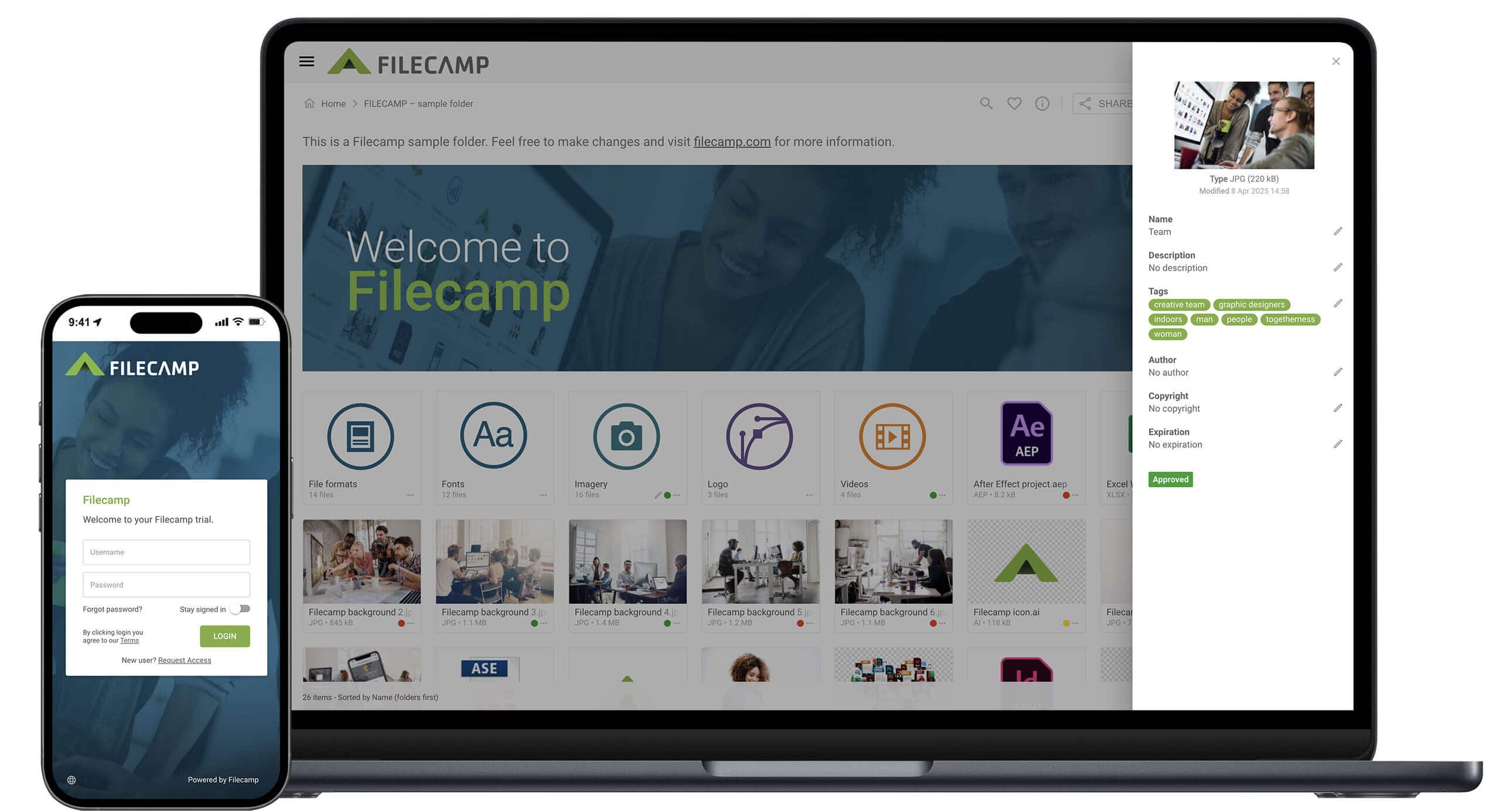Brand Asset Management
How to Execute a Rebrand
(And How DAM Can Help)
Even the most established and innovative brands find themselves at a crossroads when their visual identity doesn’t reflect the company’s mission, values or market position.
There comes a time when marketing materials feel disconnected and outdated. When brands simply can’t capture the essence of what their business has evolved to be. When you simply aren’t connecting with the right kinds of customers, or you’re struggling to meet your audience’s expectations. These are all situations all too familiar to business owners and marketing professionals.
This is where rebranding becomes vital for businesses to remain relevant, capture new market segments, bring their visual identity into the modern generation, or simply reflect what their business has become now. This decision represents a process that brings plenty of excitement and potential, as well as challenges.
Many marketing experts mistakenly presume that a rebrand is all about creating a new logo and slapping a new ‘lick of paint’ on their website. It’s quite the opposite; a rebrand is all about orchestrating a comprehensive upheaval of your visual assets, from your website pages and social media strategy to your internal communications, product packaging, and printed marketing materials, and everything in between. With every rebrand comes a plethora of new-and-improved digital assets, all of which require streamlined and efficient management, not to mention the complex task of ensuring consistent, regular implementation across all touchpoints.
As experts in brand asset management and DAM solutions for businesses, we recognize the importance of using best-in-class technology to streamline your rebrand project and maintain the integrity of your brand in the long run. Here, we’ll guide you through everything you need to know about succeeding with a rebrand and how DAM can be a vital asset in that field. Even if you’re not currently rebranding, these steps can still be applied to give you improved brand governance and oversight of your materials and wider visual identity.
Recognizing When Your Brand Needs a Refresh
The decision to undergo a rebrand is one that rarely takes shape overnight. The rebranding journey typically begins after companies realize that their current brand identity isn’t serving their business and customer base effectively.
Companies often refresh the appearance and perception of their products, services, and business to influence how customers perceive them. This can come in the form of minor adjustments to these elements, or by undertaking a comprehensive rebrand of their entire visual portfolio, from their internal systems to their wider customer-facing assets.
Companies may be considering a rebrand because they want to:
- Bring their business in line with new changes and evolution in their industries
- Reposition themselves and remain competitive with other businesses
- Strike the right emotional connections with consumers whose preferences may have evolved
- Modernize and freshen up their aesthetic appearance
- Expand their appeal to a wider audience and new market segments
- Navigate through and resolve a PR crisis
- Bring more cohesion and consistency to their marketing materials
- Reflect new service or product offerings
- Support a new and evolved business model
- Align with partners or stakeholders’ requests following mergers, acquisitions or buyouts
Tech companies from the early 2000s look starkly different to how they did back in that era. Their visual identities now are a far cry from what was considered innovative and game-changing back then. The shift from skeuomorphic design elements to minimalist, modern and mobile-friendly aesthetics didn’t happen in the blink of an eye. They reflect broader changes in how consumers interact with digital media both then and now.
Perhaps your organization may be serving enterprise clients now rather than small businesses, prompting a change in your brand assets. Your social media graphics may use different color schemes than those on your website and sales presentation templates, leaving you in a state of brand asset fragmentation. This is quite common for growing companies.
What is a Brand Asset in Marketing?
Before talking about the complexities and processes of rebranding, it’s important to isolate exactly what we mean by brand assets.
Definition of Brand Assets
A brand asset is any visual, auditory or written element that represents your company’s identity and helps communicate your message(s) to your audience.
Traditional brand assets include:
- Your company logo (horizontal, vertical, monochrome, simplified and more)
- Color palettes for digital and print
- Typography and fonts for headers and body text
- Illustration and photography styles
- Iconography
- Design templates for materials like social media posts, emails, presentations, etc.
However, modern brand asset libraries now extend far beyond these basics to encompass a broad range of digital materials that support platform-wide brand communication.
Brand assets also extend to interactive elements like:
- Social media headers, footers, pictures, and post types
- Website components like banners, headers, footers, CTAs, and more
- Video intro and outro sequences and titles or text overlays
- Templates for paid advertisements on the Google Display Network or social media channels
- Interactive email content like mailshots, newsletters, and more
- Article, blog post and case study templates and titles
- Thumbnails for YouTube videos, Instagram stories/reels and TikTok posts, among others
Consider the complexity of maintaining brand consistency across all social media and digital channels. Each element requires different dimensions, resolutions and sometimes different design approaches if you’re trying to make each brand element memorable and recognizable.
The most critical brand asset is the documentation and guidelines that explain how all other assets should be used. This includes brand style guides, usage instructions, do’s and don’ts, examples, and other templates that you can use as a guideline to create further, better materials, all while supporting your brand consistency goals.
Effective brand guidelines anticipate common use cases and provide clear direction for maintaining brand integrity across different applications and contexts.

How to Plan and Execute Your Rebrand
1. Research and Preparation
The foundation of any successful rebrand project lies in thorough research and a full understanding of your current market position, competition, and your target audience’s current needs and preferences.
Market research should examine direct competitors and brands you aspire to be like from your current and adjacent industries. Ask yourself:
- What visual strategies are working in your space?
- Where do you see opportunities to set yourself apart?
- How do you want to be perceived?
- Is how you’re being perceived now acceptable?
Any discussions about logos, templates and photography should be preceded with a series of conversations to determine strategic vision. What business objectives with this rebrand support? Are you looking to attract a new audience demographic? Are you changing your company’s direction? Are you simply trying to modernize an outdated aesthetic?
Set measurable and achievable goals to help ensure your rebrand delivers tangible business value rather than just providing an aesthetic facelift.
2. Conduct a Brand Asset Audit
Understanding what you have currently is vital before determining what you need. A thorough brand asset audit gives you a full catalog of all existing materials, from your logo files and brand guidelines to website imagery, marketing collateral, promotional materials, and more.
This process often reveals the true scope of a rebrand project. Many businesses underestimate how many touchpoints their brand identity affects, from business cards and email signatures to trade show displays and even company vehicle branding. A thorough audit ensures nothing gets overlooked during the pivotal transition.
3. Develop and Create Your New Assets
The creative development phase can only begin once your strategic foundations have been laid. This is the process when your new brand identity takes shape, through logo design, template design, typography testing, the creation of new compelling and dynamic visual content and the development of supporting visual elements.
During this phase, it’s important to look beyond the primary logo. Consider how your brand will appear across different applications, from social media feeds and sponsored video ads to large-scale signs and printed materials. Variations and applications will need to be created and tested to support brand recognition and consistency, while adapting to different contexts.
For businesses looking to create compelling visual content without the luxury of a huge production budget, resources like MPB's guide to cameras for beginners can help teams acquire the right equipment for producing professional-quality brand photography and video content in-house. This is more cost-effective than outsourcing to third-party agencies for photography and videography.

4. Organize and Manage Assets
As your new assets are created, it’s important to establish a robust and valid organization system. This is often where many rebrands struggle, as without proper asset management, the most striking, memorable, modern and vibrant brand elements can quickly become fragmented, disorganized and inconsistently applied.
Effective digital brand asset management involves creating:
- Logical parent and child folder structures
- Consistent naming conventions
- Proper version control systems
- Centralized repositories
- Metadata tagging
- Access control and permission settings
- Authentication protocols for sensitive or restricted materials
5. Adding and Launching New Assets
The implementation phase involves carefully coordinating your use of new assets to ensure consistent applications across all touchpoints. This involves:
- Updating your website
- Replacing printed materials
- Updating social media profiles
- Rolling out new images and videos
- Applying templates correctly in dynamic and interactive content
- Proofreading and validating correct formats
A phased rollout often works best, where high-visibility touchpoints (website, social media profile(s), client communications, etc) are prioritized while less critical materials are updated down the line. This approach helps manage costs and ensures proper quality control during the transition period.
Even the most well-designed brand assets won't maintain consistency if team members don't understand how to use them properly. Ensure proper training on and understanding throughout your team of the new brand guidelines, and clarify any unclear usage instructions to avoid any implementation mistakes.
The Role of Digital Asset Management (DAM) in Rebranding
Many businesses focus intensively on the initial rebrand process, narrowing in on the creation and deployment of new assets without any proven systems to manage new brand assets. This oversight of proper brand governance causes inconsistencies in application and an abundance of mistakes.
Those that do attempt to manage their rebranded assets often use basic file storage solutions like cloud folders, shared drives, and similar storage media. While these approaches might be sufficient for small teams with minimal assets, these become harder to suffice as the volume and complexity of brand materials grow, not to mention the business itself.
Traditional storage methods lack the organizational tools, search capabilities, and access controls necessary for effective brand asset management. Without proper metadata, finding specific asset variations becomes difficult, time-consuming and resource-intensive. Without appropriate version control, team members might unknowingly use outdated materials, potentially landing themselves and the business in hot water.
Digital asset management platforms provide the essential infrastructure for sophisticated, successful brand asset projects, from the audit and organization stages to those of distribution and ongoing support. Key functionalities include (but are not limited to):
- Metadata-based organization - to improve searchability
- Automated tagging - to speed up file organization
- Version control - to ensure all users can access the most up-to-date assets
- Usage analytics - to show which assets are being used most frequently
- Robust permission settings - to control who has access to specific assets
FileCamp's Approach to Brand Asset Management
FileCamp addresses the specific challenges that arise during rebranding by providing comprehensive brand asset management capabilities designed for marketing and creative teams.
The FileCamp’s robust structure supports the categorization of assets that emerge when managing multiple variations, including those for time-sensitive campaigns or products under strict embargoes until suppliers give the go-ahead.
The simple search feature within FileCamp becomes particularly valuable during rebrands, especially when team members need to quickly locate specific logo variations for coordinated posts across multiple social media channels, or template files to begin planning and scheduling new material. Rather than perusing through complex folder structures, users can use natural language search that leverages metadata and tagging.
FileCamp’s strong collaboration features support the cross-departmental and functional work needed during rebrands, empowering dispersed teams in design, marketing, and external departments to access appropriate materials while maintaining sufficient control over assets, however sensitive. For comprehensive guidance on maintaining organized asset libraries that support long-term brand consistency, FileCamp's approach to organized image library management provides valuable insights into sustainable asset organization strategies.

Your Successful Rebrand Starts with Digital Asset Management
It’s clear that executing a successful rebrand involves more than a creative vision and a strategic mind. It demands practical, actionable systems and processes for managing a complex array of brand assets that work together to bring your new-and-improved brand identity to life.
The volume and variety of marketing materials generated during a rebrand can quickly become overwhelming without proper organization and management. The companies that achieve long-term success from their rebranding efforts are those that invest in and implement DAM solutions that can support:
- Easy asset discovery
- Consistent version control
- Efficient distribution
Whether you’re a growing startup business ready to shed your hastily-made initial materials or an established brand looking to diversify and enter new, competitive market conditions, your rebrand’s success ultimately hinges on your ability to remain consistent across your touchpoints. DAM transforms what could be a chaotic and volatile process into a well-managed, properly controlled one that supports your brand’s growth and evolution.
For marketing and creative teams ready to take control of their brand assets and streamline their rebrand process, FileCamp’s asset management solutions represent the best possible step you can take toward rebrand success. The initial investment will pay long-term dividends through better brand consistency, improved productivity and the ability to adapt to change quickly and confidently.

Chester Avey
Share this Post
